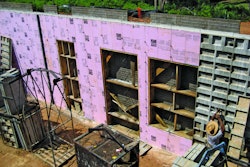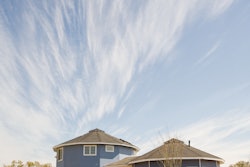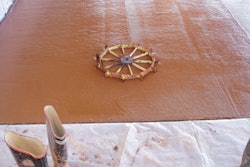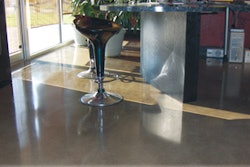Environmental building trends have a firm hold on the construction industry. Many states and municipalities are requiring a certain level of green or sustainable steps in their new building projects. Homeowners and commercial building owners alike are looking for ways to save money on energy bills through energy efficient designs in their new buildings. Other owners look to ensure their new structures offer people a safe place to live or work.
"Going green" can mean different things for different contractors, and it can be difficult to keep up on what's going on in the industry. As a concrete contractor it's important to know how concrete can contribute to sustainable design now and what's on the horizon.
In May, Concrete Contractor attended the "Concrete Technology Forum: Focus on Sustainable Development." Sponsored by the National Ready Mixed Concrete Association (NRMCA), the forum was a meeting place for members of the industry interested in learning where concrete manufacturers are headed in regards to sustainable design and green building. This article serves as a report on some of the topics discussed.
The latest in the industry
When looking at concrete as a sustainable product, there are two sides to the story. You can look at the negative side, where greenhouse gases are created during cement production and natural resources such as sand, stone and water are mined. Fuel issues also arise in regards to the energy used for mining and transporting concrete's ingredients.
The positive side looks at the benefits of concrete in a sustainable building project. Concrete is made up largely of local materials, it offers the potential for an energy efficient design and the structures it is built with have a long usable life. Following are some of the ways concrete excels in green building design and some information on the latest trends in these areas. Many of these techniques and products can be used to earn points toward a green certification.
Supplementary Cementicious Materials (SCMs). The cement industry is working to reduce the amount of CO2 emissions in cement production. It's also lowering cement's carbon footprint by using supplementary cementicious materials (SCMs), which replace a portion of cement in a concrete mix.
Contractors have been getting two popular SCMs ? fly ash and blast slag ? in their mixes for years. Research continues in the industry in regards to perfecting these mixes and integrating new sources of SCMs. Concrete contractors often work closely with their ready mix suppliers to test mix designs taking SCM replacement percentages higher and higher.
Other SCMs being used and tested in the industry include silica fume and fine glass powder, a by-product of the retroreflectivity glass ball industry that acts a lot like a fly ash. There's also work out there on replacing a portion of cement with ground limestone. Normal practice in the industry uses replacement up to 5 percent, but some manufacturers are looking to boost replacement levels up to 10 percent.
Recycling. There are several roads to travel in regards to recycling and concrete. Industry sources estimate that 5 percent of all ready mix is returned to the plant. This extra concrete can be used to form landscape blocks, paving at the plant or allowed to harden and then demolished into Crushed Concrete Aggregate (CCA) for use as aggregate back into a mix. This practice keeps material out of a landfill and saves suppliers money they would otherwise spend on virgin aggregate.
Another practice involves ready mix plants separating the returned concrete, basically taking apart the ingredients in a concrete mix with a reclaimer. They also have water recycling programs in use that allow them to reuse wash water.
Recycled Concrete Aggregate (RCA) is a product in which steel and other debris is separated out from the concrete and the concrete is crushed for use as road base, fill, landscaping material, soil stabilization, and in some situations as aggregate for ready-mixed concrete and asphalt.
Pervious concrete. Pervious concrete is used to manage stormwater runoff, and in some cases eliminates the need for retention ponds. By allowing rain and snow melt to soak into the ground, pervious concrete helps recharge aquifers.
There are many unique applications for pervious concrete happening throughout the industry, including paving for residential streets and decorative applications. At the University of Tennessee at Chattanooga, pervious concrete is being used for water harvesting; water from a pervious parking lot is diverted to a cistern, then used to water the athletic field.
In the field, concrete contractors and ready mix suppliers have worked side-by-side in moving the pervious market forward. The NRMCA has already certified more than 3,500 contractors through its pervious certification program. The RMC Research & Education Foundation's study from December 2007, "Pervious Concrete Pavement: Field Performance Investigation on Parking Lot and Roadway Pavements," laid to rest many of the concerns people had with pervious concrete in freeze/thaw environments and made pervious concrete a national product. The NRMCA also offers contractors pervious pavement promotional brochures and an educational seminar on the topic.
Albedo, or solar reflectance. In sustainable building situations, there are benefits to paving parking lots, sidewalks and other impervious areas with high albedo materials, or materials with a high level of solar reflectance. Designers often choose concrete or pervious concrete over asphalt in these situations because concrete's higher light reflectance reduces the heat island effect.
Concrete mixes containing blast slag as an SCM often have a higher albedo than straight cement mixes, while "white" portland cement has a higher albedo yet (although its price would stand in the way of paving large areas).
The green contractor
Marketing your company and products as environmentally friendly can benefit your business by setting it apart from the competition. It can also make you a desirable choice for clients looking to sustainable construction.
Taking steps to green your business doesn't necessarily mean spending more money, but it takes planning. At the office you can do simple things such as buy recycled office paper, encourage employees to drink out of reusable coffee cups instead of paper or Styrofoam, and implement energy-saving initiatives to cut fuel, heating and electrical use.
On the job, talk to your clients about the steps they want to take toward sustainable projects. Let them know the experience you have in working with SCM mixes, concrete recycling or pervious concrete. Ask your ready mix suppliers about the sustainability steps they're taking at their plants and choose suppliers who have taken green steps.
Whatever your company is doing to work green, communicating these steps to customers can establish you as a "green" contractor. Even when you can't make direct decisions on a green project, being informed about what's new in the industry and how to implement them on the job is a valuable asset to your company.



















